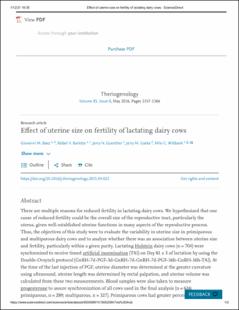Effect of uterine size on fertility of lactating dairy cows
...
Baez, Giovanni | 2016-05
There are multiple reasons for reduced fertility in lactating dairy cows. We hypothesized that one cause of reduced fertility could be the overall size of the reproductive tract, particularly the uterus, given well-established uterine functions in many aspects of the reproductive process. Thus, the objectives of this study were to evaluate the variability in uterine size in primiparous and multiparous dairy cows and to analyze whether there was an association between uterine size and fertility, particularly within a given parity. Lactating Holstein dairy cows (n = 704) were synchronized to receive timed artificial insemination (TAI) on Day 81 ± 3 of lactation by using the Double-Ovsynch protocol (GnRH-7d-PGF-3d-GnRH-7d-GnRH-7d-PGF-56h-GnRH-16h-TAI). At the time of the last injection of PGF, uterine diameter was determined at the greater curvature using ultrasound, uterine length was determined by rectal palpation, and uterine volume was calculated from these two measurements. Blood samples were also taken to measure progesterone to assure synchronization of all cows used in the final analysis (n = 616; primiparous, n = 289; multiparous, n = 327). Primiparous cows had greater percentage pregnant/AI (P/AI) compared to multiparous cows (49.8% vs. 39.1% at 67 days of pregnancy diagnosis, P = 0.009). Diameter, length, and volume of the uterus were larger in multiparous than in primiparous cows (P < 0.001). For multiparous cows, uterine diameter and volume were smaller in cows that became pregnant compared to cows that were not pregnant to the TAI with a similar tendency observed in primiparous cows. Logistic regression and quartile analysis also showed that as uterine volume increased, there was decreased P/AI in either primiparous or multiparous cows. Thus, there is a negative association between uterine size and fertility in lactating dairy cows with a larger uterus associated with reduced fertility, particularly for multiparous cows.
LEER










